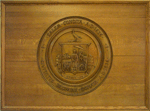Salem Redevelopment Authority
In the early 1960's Salem's downtown shops and businesses were facing eroding sales, partly from the opening of the new North Shore Shopping Center in nearby Peabody. A comprehensive plan for the renewal of downtown Salem was necessary. In 1962, Mayor Francis X. Collins created a special department to handle urban renewal in Salem. The Salem Redevelopment Authority was created. It began researching, devising and implementing a total plan in order to secure Federal grants from HUD. The plan was to demolish 39 acres of the city's downtown commercial district called Heritage Plaza East. At the time, rehabilitation was considered economically unfeasible.
Beginning in 1968, demolition began and some 25 buildings were leveled. The one building that brought demolition to a standstill was the home of Bessie Munroe on Ash Street. She refused to leave. Because she was old and frail, they let her stay.
Things changed in 1970 when Samuel E. Zoll became mayor and appointed Tim Noonan and Bill Tinti to the SRA. These members brought a new approach. They tried to retain the buildings by recognizing the value of them rather than tearing them down. Under the new SRA, imaginative techniques were devised to save old buildings. Salem became the first community in the country to use urban renewal funds for historic renovation rather than demolition.
Nearly 50 buildings were rehabilitated and more than a dozen new buildings were built. One technique they used to refresh the buildings was "facade easements" of 33 historic buildings. Today, many of the originally doomed buildings still stand, including the Bowker Block, bought by L.H. Rogers and the brick buildings around Old Town Hall.
Today, the Authority is part of the Planning and Community Development Department at the Salem city level, meeting monthly.
The Department of Planning and Community Development (DPCD) coordinates the city's efforts with state agencies and regional planning commissions and it oversees the operation of the Planning Board, Conservation Commission, Historical Commission, Zoning Board of Appeals, Harbor Plan Implementation Committee, Artist’s Row, and the Salem Redevelopment Authority. The Department also administers the City's $1.5 million federal Community Development Block Grant and HOME Programs.
According to the city site, the Salem Redevelopment Authority (SRA) and its Design Review Board (DRB) have played an active role in the redevelopment of downtown Salem since it was created in 1962. Over the past four decades, the SRA has made significant contributions to the revitalization of the Central Business District in downtown Salem. Critical to this success is its commitment to preserving the social fabric and architectural heritage of the City.
The SRA requires that all improvements to the exterior of a structure and any changes to signage to properties located within the Urban Renewal Areas undergo design review. The SRA utilizes their Urban Renewal Plans in that design review. The Commercial Design Guidelines are intended to supplement the design frameworks established by the Urban Renewal Plans and the SRA staff are available to help you as you put together your application.
See Also
- Vertical File in the Salem Room - Salem Redevelopment Authority
- Essex Institute Historical Collections Dec. 1983, p. 238-252 "Heritage Plaza East: Salem's Experiment in Urban Renewal" by David K. Goss
- "Salem; Urban renewal area" Architectural Record, Dec. 1977, p. 97-99
- "City agency touts loan to business" Salem Evening News, May 26, 1994, p. 1
- "Revived SRA would carry noble new agenda" Salem Evening News, Jan. 6, 2000, p.A3
